
Understanding Sauna Technology: A 2025 Guide for Wellness at Home

Home sauna technology has surged ahead in 2025, bringing together ancient relaxation rituals with innovations that would shock even longtime wellness fans. Smart saunas now let you adjust heat and humidity from your phone, but it is the health data that might surprise you. Some models track heart rate and stress, turning a simple sweat session into a personalized health checkup. Saunas are no longer just about getting hot. The real breakthrough is how these connected chambers are rewriting what recovery and daily wellness actually mean.
Table of Contents
- How Sauna Technology Works Today
- Comparing Traditional And Infrared Saunas
- Key Health Benefits Of Sauna Use
- Choosing The Right Sauna For Your Home
Quick Summary
| Takeaway | Explanation |
|---|---|
| Modern sauna technology integrates smart features | Today’s saunas utilize Wi-Fi-enabled technologies for precise control over temperature, humidity, and session metrics, enhancing user experience and personalization. |
| Choose between traditional and infrared saunas based on your needs | Traditional saunas operate at higher temperatures and produce intense heat, while infrared saunas offer gentler heat and deeper tissue penetration, making them more accessible for some users. |
| Regular sauna use provides significant health benefits | Sauna sessions improve cardiovascular health, enhance muscle recovery, and promote mental well-being, making them an effective addition to holistic health management. |
| Consider space and budget when selecting a sauna | Different sauna types require various installation considerations. Assess your space, electrical needs, and long-term operational costs before making a decision. |
| Research and recommendations are crucial for informed choices | Seek insights from wellness professionals, customer reviews, and warranty options to ensure that the selected sauna fits your health goals and budget effectively. |
How Sauna Technology Works Today
Sauna technology has evolved dramatically, transforming from simple heated rooms to sophisticated wellness systems that deliver precise health benefits. Modern sauna designs leverage advanced heating techniques and smart technologies to create personalized relaxation and recovery experiences.

The Science of Heat Generation
Today’s sauna technologies primarily utilize two fundamental heating approaches: traditional thermal heating and cutting-edge infrared radiation. Infrared sauna technology represents a revolutionary approach to heat therapy. Unlike traditional saunas, infrared systems use specialized panels that generate radiant heat directly penetrating human body tissues. According to Hydro Spa Outlet, these saunas operate at lower temperatures (150-195°F) while providing deeper physiological responses.
Traditional dry saunas, by contrast, use electric heaters or wood-burning stoves to warm specialized rocks that radiate intense heat. The River Source notes these environments typically reach temperatures between 158°F and 230°F, with extremely low humidity levels of 10-20%. This environment causes significant physiological changes, including blood vessel dilation and heart rate increases comparable to moderate exercise.
Smart Sauna Technology Emergence
The 2025 sauna landscape is characterized by intelligent, connected systems that transform user experiences. Haven of Heat highlights the rising trend of Wi-Fi-enabled sauna technologies that allow unprecedented control and personalization. Users can now adjust temperature, humidity, and session duration directly through smartphone applications.
These smart systems offer multiple advantages:
- Precise Temperature Control: Digital interfaces enable exact heat management
- Energy Efficiency: Intelligent heating systems optimize power consumption
- Personalized Experience: Custom preset configurations for individual preferences
- Remote Monitoring: Track session metrics and health data in real time
Technological Performance and Health Integration
Modern sauna technologies are not just about heat generation but comprehensive wellness integration. Advanced models now incorporate biometric sensors that can track heart rate, body temperature, and even stress levels during sessions. This technological convergence transforms saunas from simple heat chambers into holistic health monitoring platforms.
The electrical and thermal engineering behind contemporary saunas ensures rapid heating, consistent temperature maintenance, and safety features that protect users. Ceramic and carbon fiber heating elements provide more uniform heat distribution compared to older technologies, creating a more comfortable and effective wellness experience.
As understanding sauna technology continues to progress, we can expect even more sophisticated systems that blend cutting-edge technology with ancient healing practices, offering users unprecedented control over their personal wellness journey.
Comparing Traditional and Infrared Saunas
Choosing between traditional and infrared saunas involves understanding their unique characteristics, technological approaches, and wellness benefits. While both technologies aim to provide relaxation and health improvements, they differ significantly in heat delivery, user experience, and physiological impacts.
Heating Mechanisms and Temperature Dynamics
Traditional saunas and infrared saunas employ distinctly different heating strategies. Salus Saunas highlights that traditional saunas operate at substantially higher temperatures, ranging from 150°F to 195°F, whereas infrared saunas maintain lower temperatures between 110°F and 140°F.
Traditional saunas heat the surrounding air, creating an environment where users experience intense heat and high humidity. In contrast, infrared saunas use specialized light waves that directly penetrate body tissues. According to Purple Yoga, this direct heating mechanism promotes faster detoxification and more targeted relaxation compared to traditional heat exposure.
Energy Efficiency and Operating Costs
The technological differences between these sauna types extend beyond heating methods to include significant variations in energy consumption and operational expenses. Michael Kummer reports that infrared saunas demonstrate superior energy efficiency due to their lower heat requirements and faster warm-up times.
Key efficiency considerations include:
- Lower Energy Consumption: Infrared saunas require less electricity
- Quicker Heat-Up Times: Reduced waiting periods for optimal temperature
- Targeted Heat Delivery: More direct energy transfer to body tissues
- Reduced Operating Expenses: Lower electricity costs compared to traditional models
Health Benefits and User Experience
While both sauna types offer wellness advantages, their distinct technological approaches create nuanced physiological responses. Traditional saunas trigger intense sweating through high-temperature air exposure, stimulating cardiovascular responses similar to moderate exercise. Infrared saunas, by contrast, provide a gentler heat experience that allows for longer, more comfortable sessions.
Users with heat sensitivity or cardiovascular conditions might find infrared saunas more accessible. The lower ambient temperatures and direct tissue heating create a less stressful environment while still promoting significant metabolic benefits such as improved circulation, muscle recovery, and potential stress reduction.

Understanding sauna technology means recognizing that neither approach is universally superior. The optimal choice depends on individual health goals, physical tolerance, and personal comfort preferences. Technological advancements continue to refine both traditional and infrared sauna experiences, offering increasingly sophisticated wellness solutions for home users seeking relaxation and health optimization.
Key Health Benefits of Sauna Use
Sauna use has emerged as a powerful wellness practice with comprehensive health benefits that extend far beyond simple relaxation. Modern research reveals multiple physiological advantages that make regular sauna sessions a strategic approach to holistic health management.
Cardiovascular and Metabolic Wellness
Modern Chiro Clinic highlights that sauna sessions provide significant cardiovascular benefits by mimicking moderate exercise effects. The intense heat causes blood vessels to dilate, improving circulation and potentially reducing blood pressure. This cardiovascular stimulation creates responses similar to low-intensity physical activity, offering notable health advantages for individuals with limited mobility.
The metabolic impact of sauna use is equally remarkable. Heat exposure triggers increased heart rate and metabolic rate, which can support weight management and enhance overall metabolic function. Research suggests these sessions can help burn calories, improve insulin sensitivity, and potentially support metabolic health.
Muscle Recovery and Physical Performance
Athletes and fitness enthusiasts increasingly recognize saunas as critical recovery tools. The heat-induced vasodilation promotes faster muscle recovery by increasing blood flow and reducing inflammation. According to PsyPost, regular sauna users report higher energy levels and reduced physical pain.
Key physical performance benefits include:
- Enhanced Muscle Relaxation: Reduces muscle tension and soreness
- Improved Circulation: Supports faster recovery after intense workouts
- Reduced Inflammation: Helps manage post-exercise muscle stress
- Accelerated Healing: Promotes faster tissue repair
Mental Health and Stress Reduction
Beyond physical benefits, sauna technology offers profound mental health advantages. The controlled heat environment creates a meditative space that promotes stress reduction and psychological relaxation. Consistent sauna use has been linked to decreased cortisol levels, improved mood regulation, and enhanced overall mental well-being.
The neurological benefits extend to potential improvements in sleep quality and stress management. By triggering the release of endorphins and promoting deep relaxation, sauna sessions provide a natural approach to mental health support. The combination of heat, solitude, and physiological changes creates a holistic wellness experience that addresses both mental and physical health.
Understanding sauna technology reveals it is more than a luxury—it is a sophisticated wellness tool capable of delivering comprehensive health benefits. As research continues to uncover the intricate connections between heat exposure and human physiology, saunas are increasingly recognized as an essential component of proactive health management.
Choosing the Right Sauna for Your Home
Selecting the ideal sauna for your home requires careful consideration of space, budget, health goals, and personal preferences. With multiple sauna technologies and designs available, understanding your specific wellness needs becomes crucial in making an informed decision.
Sauna Types and Configuration Options
The Spruce identifies four primary home sauna categories, each offering unique benefits and installation requirements:
- Infrared Saunas: Utilize light waves for direct body heating
- Steam Saunas: Generate moist heat for intensive sweating
- Portable Saunas: Offer flexible, non-permanent installation options
- Traditional Wooden Saunas: Provide classic dry or wet heat experiences
Each type presents distinct advantages depending on available space, budget constraints, and individual wellness objectives. Infrared models work exceptionally well in compact spaces, while traditional wooden saunas offer a more immersive, authentic experience.
Space and Installation Considerations
Home sauna selection demands thorough spatial evaluation. Indoor installations require dedicated electrical circuits, proper ventilation, and moisture-resistant flooring. Outdoor models need weatherproof construction and protection from environmental elements.
Key spatial factors include:
- Square Footage: Determine precise room dimensions
- Electrical Requirements: Verify circuit capacity and voltage
- Ventilation: Ensure adequate air circulation
- Moisture Management: Protect surrounding surfaces
Consider professional consultation to assess your home’s specific infrastructure and compatibility with different sauna technologies. Some models require professional installation, while others offer more user-friendly, modular designs.
Budget and Long-Term Value
Budget considerations extend beyond initial purchase price. Evaluate long-term operational costs, energy efficiency, maintenance requirements, and potential health benefits. Higher-end models might offer advanced features like smartphone connectivity, integrated health tracking, and superior heat distribution.
Factor in additional expenses such as:
- Initial Purchase Cost: Range from $2,000 to $15,000
- Electrical Installation: Potential expenses for circuit upgrades
- Maintenance: Regular cleaning and potential component replacements
- Energy Consumption: Ongoing electricity expenses
Prioritize models that offer comprehensive warranties, energy-efficient technologies, and proven performance records. Research customer reviews and seek recommendations from wellness professionals to make an informed investment.
Understanding sauna technology means recognizing that the right choice varies for each individual. Your ideal sauna should align with your physical space, wellness goals, and personal comfort preferences. Take time to explore different options, consult experts, and prioritize a solution that transforms your home into a personalized wellness sanctuary.
Frequently Asked Questions
What is the difference between traditional and infrared saunas?
Traditional saunas operate at higher temperatures (158°F to 230°F) by heating the air, while infrared saunas use lower temperatures (110°F to 140°F) with infrared light that directly heats the body, allowing for deeper tissue penetration.
How can smart sauna technology enhance my experience?
Smart sauna technology allows you to control temperature, humidity, and session metrics from your smartphone, providing precise adjustments and a personalized wellness experience during each session.
What are the health benefits of using a sauna regularly?
Regular sauna use can improve cardiovascular health, enhance muscle recovery, and promote mental well-being by decreasing stress levels and improving mood through the release of endorphins.
What should I consider when choosing a sauna for my home?
Consider factors like the type of sauna (infrared, steam, traditional), available space, installation requirements, budget, and long-term operating costs to find the best fit for your wellness goals.
Bring Cutting-Edge Sauna Wellness Home Today
Are you searching for a smarter, more effective way to experience relaxation and health benefits at home? If the latest advancements and options in sauna technology have inspired you but you feel overwhelmed by choices, you are not alone. Many readers want to harness the power of infrared and traditional sauna systems but struggle to find quality solutions and trusted support.
Best Life Sauna has made it easy to leap from research to real results. We understand your goals, whether it is tracking your wellness with smart features, enjoying personalized heat therapy, or simply finding a reliable sauna for recovery, stress relief, and holistic health. Our curated range includes premium infrared, traditional, and outdoor saunas with modern tech upgrades—all designed to support your lifestyle. Plus, enjoy benefits like free shipping on orders over $200, a price match guarantee, and top-rated customer satisfaction.

Ready to create your own wellness sanctuary at home? Explore premium sauna solutions at Best Life Sauna and take advantage of exclusive offers happening now. Tap into smarter health and relaxation—start your journey to feeling better every single day with products designed around the needs discussed in this article.

